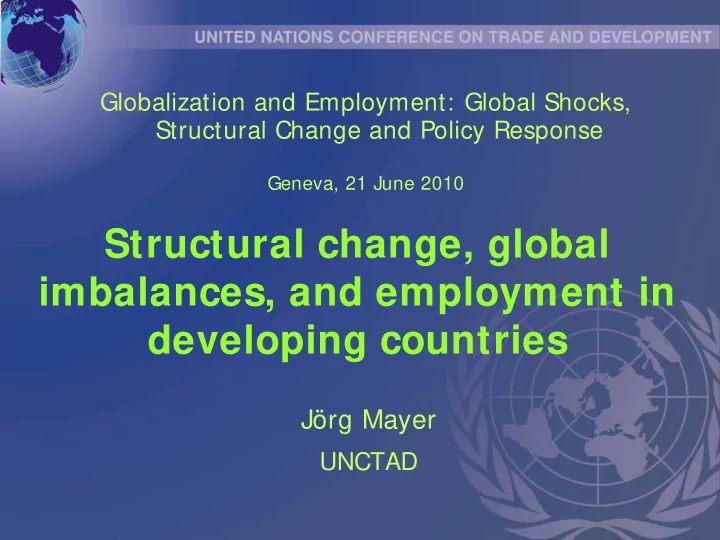

Globalization and Employment: Global Shocks, Structural Change and Policy Response Geneva, 21 June 2010 Structural change, global imbalances, and employment in developing countries Jörg Mayer UNCTAD
Overview • Medium-term shifts in the structure of world demand • Global rebalancing: which countries’ consumer demand could make up for the decline in United States consumer demand? • Potential impact of global rebalancing , led by the US and China, on trade flows and employment • Conclusions
1. Medium-term shifts in the structure of world demand • The level and structure of world trade depends on relative importance of rich and poor countries in global economic growth • Non-homothetic demand preferences present at international level (e.g. rich countries consume and import more consumer durables than poor ones) • The import content differs across different elements of demand and across different countries • Imperfect similarity of composition of consumer- good import baskets
2. Which countries could make up for decline in US consumer demand? • Bipolar perspective – China and US: – Sizeable share of global imbalances – Recent growth trajectories have developed in opposite directions • US: external deficit, and high and rising share of private consumption in GDP • China: external surplus, and low and declining share of private consumption in GDP • But other, especially surplus, economies need to contribute to global rebalancing
Consumer goods account for over 85% of the increase in the US non-energy trade deficit United States current-account balance and trade balance by end-use category, 1980–2009 ($bn) 100 - 100 - 300 - 500 - 700 - 900 -1 100 1980'81 '82 '83 '84 '85 '86 '87 '88 '89 '90 '91 '92 '93 '94 '95 '96 '97 '98 '99 '00 '01 '02 '03 '04 '05 '06 '07 '08 '09 Foods, feeds, beverages, and exports and imports nes Industrial supplies and materials (excl energy) Energy Capital goods Consumer goods (nonfood), incl autos Current account balance
China’s level of consumption is too small to compensate for declining US consumption Household consumption: average level 2007–2008, selected countries and country groups, $bn 10 000 9 000 8 000 7 000 6 000 5 000 4 000 3 000 2 000 1 000 0 United States EU-15 of which: Japan China India Major Germany petroleum exporters in West Asia
China’s consumer-good imports too different to compensate for declining US consumption Composition of consumer good imports, selected countries and regions, 1992–2008, per cent of similarity relative to the United States 100 90 80 70 60 50 40 30 20 10 1992 1993 1994 1995 1996 1997 1998 1999 2000 2001 2002 2003 2004 2005 2006 2007 2008 China-US India-US Korea-US Japan-US Germany-US
3. I mpact of rebalancing, led by US and China, on trade flows and employment • Bipolar view adopted only for convenience • GTAP-simulation based on 3 assumptions: – a decline in United States consumption as a share of GDP by 5 percentage points – an increase in China’s household consumption as a share of GDP by 7 percentage points – a reduction in United States’ potential output by 1 percentage point relative to 2008
Labour-intensive sectors are affected most by decline in world exports Change in world exports by industrial sector and labour intensity, per cent 5 Simulated percentage change in world exports by industrial sector (per cent relative to 2008) otn 4 3 ome 2 1 i_s ppp lmt nfm nmm ele 0 fmp p_c -1 prf crp mvh tex -2 -3 lum omf -4 lea wap -5 10 15 20 25 30 35 Labour intensity by industrial sector (wages and salaries as a per cent of value added)
4. Conclusions • Cross-country differences in economic growth, as well as in contribution of consumption and exports to growth rates, played key role in accumulation of substantial global imbalances, and they will also be crucial for the reduction of global imbalances • Rebalancing confined to US and China is insufficient • Labour-intensive sectors risk being affected most adversely by US-China rebalancing • Does global rebalancing make East Asia’s export- focused development strategy unsustainable?
Thank you ! joerg.mayer@unctad.org Trade and Development Report 2010 Employment, globalization and development Launch on 14 September
Recommend
More recommend